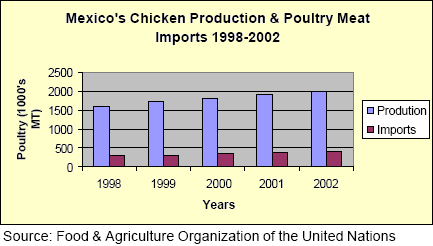



International Egg and Poultry Review
By the USDA's Agricultural Marketing Service - This is a weekly report looking at international developments concerning the poultry industry, this week looking at developments in Mexico and South East Asia.
Avian Influenza Update:
Since South Korea’s Avian Influenza outbreak in December of 2003 the disease has spread to other East Asian countries such as Vietnam, Japan, Taiwan, and suspected Thailand. To date, South Korea
has lost more than one million chickens and ducks to the flu or enforced culling of affected areas, in order to try and contain the disease. As of January 6, South Korea has confirmed 15 cases of infected poultry farms. The country’s poultry and restaurant industry have suffered, along with the 40% reduction in prices, as a result of consumer panic.
On January 5, Thailand was suspected of having the avian influenza. The Penang Poultry Farmers Association voiced their concerns over the possibility of infected live chickens being smuggled into the country do to rampant smuggling. However as of January 9 not a single case of the virus has been diagnosed. The country did battle with fowl cholera in mid-November of 2003.
Taiwan reported its first case of the bird flu January 6 when 6 ducks were smuggled into the country from mainland China, which runs rampant near Taiwan’s’ frontline island Quemoy. The ducks tested positive and were immediately destroyed. The Council of Agriculture is closely monitoring the situation to prevent any spread of the disease.
In Vietnam, the confirmed bird flu as of last week has killed as many as 100,000 chickens and ducks with an estimated 600,000 birds showing signs. In Ho Chi Minh City, about 2.5 tons of birds have died and been buried just over the course of the last few days. Authorities are trying to control the spread of the disease as panic selling of birds by local farmers is spreading the virus. Monday January 12, Vietnam requested help from the United Nations Food and Agriculture Organization, who are sending in experts to help tackle the disease. Vietnam does not export chicken. The outbreak comes just ahead of the Lunar New Year Festival of Tet in which the main course is chicken.
Monday January 12, Japan also confirmed it has avian influenza, which has killed thousands of chickens in southern Japan. Sunday night a farm in Ato in Yamaguchi, 500 miles southwest of Tokyo, lost about 6,000 birds overnight. Japan last reported having the disease 79 years ago in the 1920’s. All eggs shipped to market from the Yamaguchi farm have been recalled. The remaining 28,600 birds at the farm are to be destroyed and buried. The chickens will not be available for export. Authorities are concerned as they have identified the virus at an early state and are acting fast.
Mexico:
On December 26, 2003, Mexico's Secretariat of the Economy (SE) announced the country's 2004 NAFTA tariff rate quota (TRQ) for U.S. chicken leg quarters in Mexico's "Diario Oficial" (Federal Register.) TRQ amount is 101,000 metric tons of chicken leg quarters, which will be allocated to
each company by way of the following criteria: 40% on previous records of allocation and 60% on cold storage and sales capacity. Applications for the request of allocation of the "cupos" will be received from December 29, 2003 to January 5, 2004 for the first period, and from June 24-30, 2004 for the second period. The applications must be submitted in form SE-03-014 at the General Directorate of Foreign Trade of SE.
Broiler meat imports are expected to increase 5% from the revised 2003 import level to 295,000 tons, as a result of a strong demand in the processed foods sector. The safeguard on chicken leg quarters allows for duty free access of 100,000 tons in 2003 continuing through 2007 with a 1% growth each calendar year. Though the safeguard will limit growth of leg quarter imports to 1% annually, overall demand for other chicken products will maintain broiler export growth to Mexico. In 2002, U.S. broiler exports to Mexico were valued at $83 million.

To view the full report, including tables please click here (PDF Format)
Source: USDA's Agricultural Marketing Service - 13th January 2004









